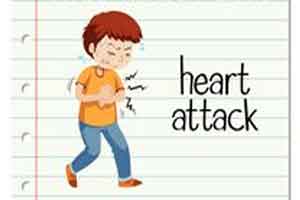- Home
- Editorial
- News
- Practice Guidelines
- Anesthesiology Guidelines
- Cancer Guidelines
- Cardiac Sciences Guidelines
- Critical Care Guidelines
- Dentistry Guidelines
- Dermatology Guidelines
- Diabetes and Endo Guidelines
- Diagnostics Guidelines
- ENT Guidelines
- Featured Practice Guidelines
- Gastroenterology Guidelines
- Geriatrics Guidelines
- Medicine Guidelines
- Nephrology Guidelines
- Neurosciences Guidelines
- Obs and Gynae Guidelines
- Ophthalmology Guidelines
- Orthopaedics Guidelines
- Paediatrics Guidelines
- Psychiatry Guidelines
- Pulmonology Guidelines
- Radiology Guidelines
- Surgery Guidelines
- Urology Guidelines
High pain tolerance may mask heart attack symptoms: AHA Study

Study Highlights
- People who have a high pain tolerance may experience “silent” heart attacks, which also puts them at risk for poor prognosis.
- Silent heart attack patients endured a pain test (cold pressor test) significantly longer than those who recognized heart attack pain.
- In a Norwegian study, more heart attacks were silent in women than in men.
Dallas : Heart attacks may go unrecognized among individuals with high pain tolerance, putting them at an increased risk for poor recoveries, according to new research in Journal of the American Heart Association, the Open Access Journal of the American Heart Association/American Stroke Association.
A heart attack does not always have obvious symptoms, such as pain in your chest, shortness of breath and cold sweats. In fact, a heart attack can happen without a person realizing it. It is called a silent heart attack, due to what is medically referred to as silent ischemia (lack of oxygen) to the heart muscle.
“It is unknown why some people experience heart attacks without symptoms. One possible explanation for the absence of chest pain is high pain tolerance. To our knowledge, no previous study has examined the relationship between pain sensitivity and recognition of heart attacks,” said Andrea Ohrn, M.D., study lead author and Ph.D. Fellow at University of Tromsø in Norway.
Researchers from Norway studied 4,849 adults who underwent a cold pressor test and electrocardiogram (ECG). The cold pressor test measured pain tolerance as participants placed their hand in ice-cold water at 3 degrees Celsius (about 37 degrees Fahrenheit) for as long as possible, up to two minutes. Researchers used ECG results and participant’s hospital records to determine heart attack status (recognized, unrecognized, or no heart attack).
They found:
- Overall, 8 percent of participants were classified as having a silent (unrecognized) heart attacks and 4.7 percent of participants as recognized heart attacks.
- Those with silent heart attack endured the cold pressor test significantly longer and were less likely to quit the test than those who recognized heart attack pain.
- Women had fewer heart attacks than men (7 percent vs. 19 percent), but a larger proportion of heart attacks were silent in women than in men (75 percent vs. 58 percent).
- More women aborted the cold pressor test compared to men (38 percent vs. 23 percent).
- However, the association between silent heart attack and lower pain tolerance was stronger in women than in men, and statistically significant in women only, but the sex difference was not statistically significant.
“Asking patients about their pain sensitivity might provide a clearer picture about their probability of presenting with heart specific symptoms in the case of a heart attack” Ohrn said. “Absence of chest pain should not lower alertness of doctors towards ischemic heart disease.”
The larger difference in pain tolerance between unrecognized and recognized heart attack in women may be because women recognized with a heart attack might be those women most sensitive to pain, presenting with the most severe symptoms, Ohrn said.
“The “silent” in a silent heart attack is the complicating factor often, a silent heart attack is discovered a while after the acute incidence at the doctor’s office or the hospital, by coincidence, if an ECG is recorded. In that case, it is very important to screen for cardiovascular risk factors, such as hypertension and cholesterol, and treat these rigorously according to existing guidelines. Also, it is important to think of a silent heart attack if a patient present with signs such as heavy breathing and swollen legs. These can be symptoms of heart failure because of a previous heart attack even though there is no record of one.”
The high prevalence and poor prognosis associated with silent heart attack, makes this a hidden public health issue that constitutes a larger proportion of women’s heart disease.

Disclaimer: This site is primarily intended for healthcare professionals. Any content/information on this website does not replace the advice of medical and/or health professionals and should not be construed as medical/diagnostic advice/endorsement or prescription. Use of this site is subject to our terms of use, privacy policy, advertisement policy. © 2020 Minerva Medical Treatment Pvt Ltd